Don't wanna be here? Send us removal request.
Text

We've seen the basic usage of transitive verbs. Let's take a look at intransitive verbs.
Kvembrian intransitive verbs come in two varieties, active and stative. Active verbs involve the volition of the participant (e.g. to jump) and have the participant decline for the agentive case. Stative verbs lack the volition of the participant (e.g. to fall) and have the participant decline for the patientive case.
Either way, the sole participant of an intransitive verb is treated as a subject for the purpose of conjugation and default word order.
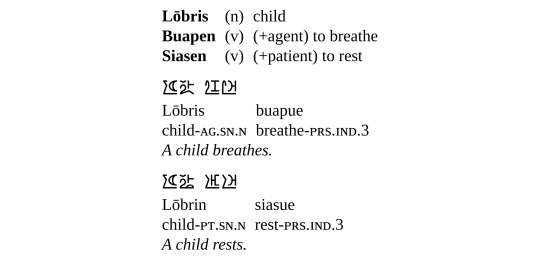
There is no marking to indicate that an intransitive verb is active or stative. The correct usage of each verb must be either intuited or memorized.
#conlang#constructed language#artlang#conworld#worldbuilding#fantasy worldbuilding#Kvembrian#Kvember
7 notes
·
View notes
Text

Let's take a look at a simple Kvembrian sentence. The example here is in the present indicative. The default sentence order for an indicative statement is subject-verb-object (SVO). The subject is glossed as ᴀɢ (agent) and the object is glossed as ᴘᴛ (patient) because of how intransitive verbs work.

Each word has been inflected for its particular usage. Nialis is declined with the agentive singular neuter suffix (default). Uokos is declined with the patientive singular masculine suffix becoming uokon. Kisken is conjugated with the present indicative third-person suffix becoming kiskue.
Because the role of each word in the sentence is marked with a suffix, it is possible to reorder the words for emphasis without introducing ambiguity, for instance, in response to the question, "what is the cat seeing?" one could answer "uokon nialis kiskue."
#conlang#constructed language#artlang#conworld#worldbuilding#fantasy worldbuilding#Kvembrian#Kvember
14 notes
·
View notes
Text

Oh joy, verb conjugations.
Regular Kvembrian verbs end in -en and conjugate as follows. The patterns are straightforward for now but will most likely break down once we evolve the language through sound changes.

Once again, we're going to kick the can down the road and cover the usage of these in later posts once the grammar has been laid out. Here is how the verb, kisken (to see), conjugates.
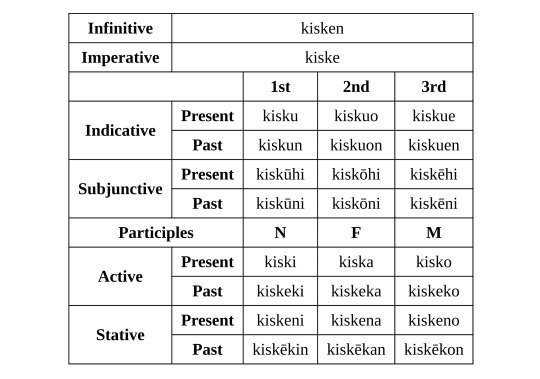
With the preliminaries out of the way, we should see an actual sentence or two next time!
Next up: Here and Now
#conlang#constructed language#artlang#conworld#worldbuilding#fantasy worldbuilding#Kvembrian#Kvember
16 notes
·
View notes
Text
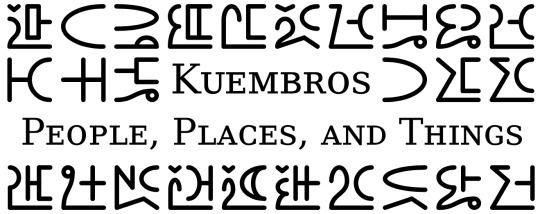
Let's talk nouns. Kvembrian is a fusional language that suffixes nouns based on grammatical gender, number (singular or plural), and case (role within a sentence).
In keeping with Kvembrian as an accessible naming language for a fantasy setting, the vowels used for neuter, feminine, and masculine nouns are -i, -a, and -o respectively. Sometimes -a and -o are raised to -e and -u.
There are four cases, active, stative, genitive, and dative. The usage of these will be detailed in a future post. The active case is the lemma form, so when transliterating Kvembrian names into other languages, they typically end in -is, -as, or -os.

Here are examples of how the nouns, nebris, eokas, and krotos would be declined in sentences.

There are a number of pronouns in Kvembrian. In addition to the earlier factors we now need to consider grammatical person as well. Unlike English, there is a clusivity distinction in the first person plurals between exclusive (us but not you) and inclusive (me/us as well as you). There is also a distinction in number for the second person (as in you vs y'all or variations thereof).

Note that at the moment, the third person pronouns are simply regular declensions of the stem, m-.
Next up: Action
#conlang#constructed language#artlang#conworld#worldbuilding#fantasy worldbuilding#Kvembrian#Kvember
11 notes
·
View notes
Text

It took a little longer than expected, but we got there! Lets talk about syllables, sounds, and the writing system.
The writing system is a syllabic alphabet, i.e. it has forms for individual letters corresponding to individual sounds, but they are arranged into blocks each corresponding to a single syllable. Let's take a look at an example, Kuembros.

If a syllable starts with a consonant, it goes on the left. The only consonant clusters in this language are formed with a plosive followed by an r, which is marked in the top left if present. The vowel(s) go in the top right. If there is a consonant at the end, it is written at the bottom connected to the initial consonant. Otherwise, a simple horizontal line takes its place.
Here are the consonants with their corresponding glyphs. Only m, n, and s may be at the end of a syllable. Their ending forms are shown underneath the table.
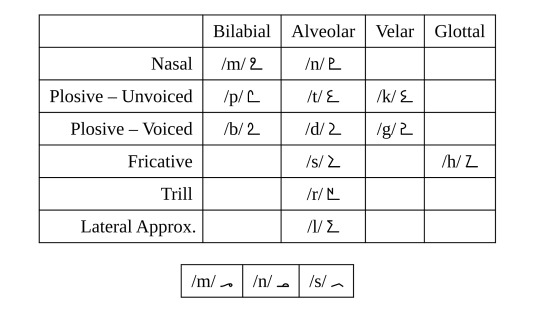
The first table below shows the plain vowels. This is the 5-vowel system. The second table shows the possible vowel combinations along with their typical realizations. Some of these are long vowels which are held for a greater duration (e.g. ā /aː/), some are diphthongs which glide from one vowel to another (e.g. /ai/ as in eye), and some starting with an i or u may be realized as a semivowel (y in you, and w in we respectively). Note that the IPA symbol for the English consonant y is /j/.
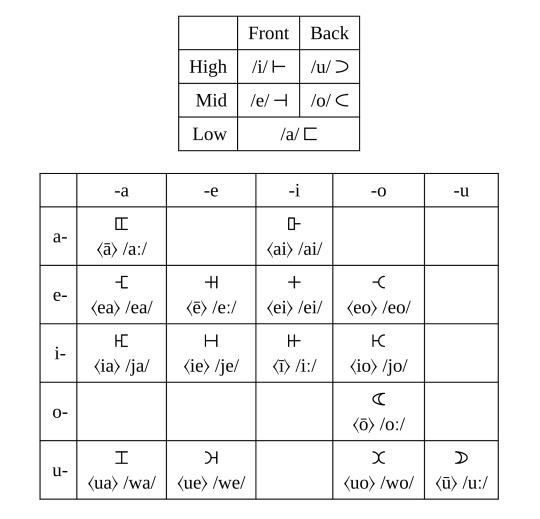
So there we have it. If you want to puzzle out some examples of the script, the banner at the top contains some randomly generated syllables of various forms.
Next up: People, Places and Things
#conlang#constructed language#artlang#neography#constructed script#orthography#conworld#worldbuilding#fantasy worldbuilding#Kvembrian#Kvember
19 notes
·
View notes
Text

Introducing, Kvembrian! Referred to as such perhaps optimistically by a beastfolk city-state with continent-conquering ambitions, it is the most widespread (spoken) language in the lowlands.
We do our conlanging a bit backwards and often start with the script and then build the phonotactics out of its constraints. We had been wanting to do a syllabic alphabet for a long time and finally figured out an aesthetic that we like. A few days of coding later, we now have a tool to convert the romanization to the glyphs you see in the image above.
More to come!
#conlang#constructed language#artlang#neography#constructed script#orthography#conworld#worldbuilding#fantasy worldbuilding#Kvembrian#Kvember
17 notes
·
View notes
Text
This is our sideblog (main: @wrendeavore) where we will be posting conlang content from hereon out. For the foreseeable future this will be content related to our worldbuilding project, Kvember, and its associated languages, thus far: Dàzn̂a, Kvembrian, and Shtaig Leiloshn.
In the near future, we'll be working on Kvembrian as well as reworking Dàzn̂a in the aftermath of the mess we made during Lexember :)
The main blog will still have linguistics and conlanging content but will probably branch out into other topics, so if you just want the conlangs, this is the blog.
#conlang#constructed language#artlang#neography#constructed script#orthography#conworld#worldbuilding#fantasy worldbuilding#Kvember
6 notes
·
View notes